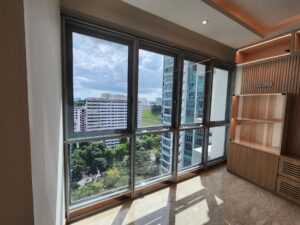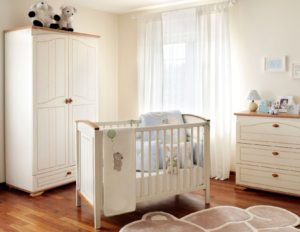As expectant parents, there’s an abundance of preparations to make before your little bundle of joy arrives, and one crucial aspect that often goes overlooked when preparing the nursery is ensuring a quite environment for your baby to sleep. As you embark on this beautiful adventure, creating a peaceful and nurturing environment for your baby is paramount, and using noise reduction and soundproofing techniques can play a pivotal role in ensuring their well-being and development.
Babies need to sleep during the day when outside notice levels are at the highest. At night for example constructions sites shut down, however during babies’ daytime nap the construction noise might be very disturbing.
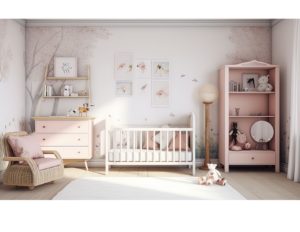
Sleep plays a crucial role during pregnancy, benefiting both expectant mothers and their precious bundles-to-be. Getting good rest helps you stay physically and mentally well, as your body goes through amazing changes. But it’s not just you – your baby also benefits from your peaceful slumber. Studies have shown that too much noise during pregnancy can stress out the little one, which might affect their development. So, creating a calm and quiet environment becomes essential to ensure a healthy pregnancy and give your baby the best start in life.
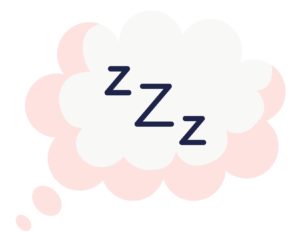
Let’s explore the 8 most important ways to ensure your baby’s room will be really quiet:
1. The Nursery Room Location:
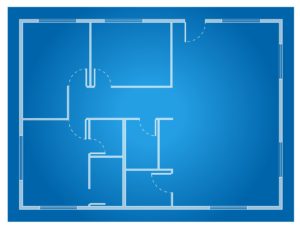
Selecting the perfect location for your baby’s room is of paramount importance for their well-being and rest and forms a solid foundation for the rest of the suggestions in this article. As you contemplate where to set up your little one’s haven, consider steering clear of high-traffic zones like the living and kitchen areas, where bustling household sounds emanate from various sources, such as clanging pots, buzzing kitchen appliances, and the ever-present television. Instead, choose a tranquil space tucked away from the main living areas, ideally positioned in the quietest nook of your home.
2. Layout of Furniture:

Creating a serene and sleep-inducing environment for your baby involves strategic furniture arrangement in their room. To begin, position the crib away from windows and doors to minimize disturbances from outside elements and drafts. Opting for an interior wall placement can further reduce external noise interference. However, be cautious not to place the crib against a shared wall with a noisy room, as sound can easily transfer through.
Additionally, consider situating the crib in a spot where you can easily see it from the doorway. This arrangement enables you to check on your baby effortlessly without causing any unnecessary disruptions while they sleep.
3. The Door:
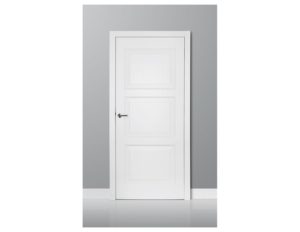
One of the main sources of noise infiltration is often the bedroom door. Hollow doors and gaps underneath allow sound to travel freely, disrupting your little one’s precious sleep. A fantastic solution to this issue is to install a solid, soundproof internal door. These sturdy doors effectively reduce noise transmission and come equipped with built-in seals on the bottom, ensuring a tight closure. Many of them also feature rubber perimeter seals, creating a sound barrier when closed. If you already have a solid door, consider retrofitting a bottom drop-down seal and adding seals to the door frame reveals to eliminate any remaining gaps. By making this simple yet effective upgrade, you’ll significantly enhance your baby’s sleep environment, reducing noise coming in and out.
Note on doors: We highly recommend NOT to install a sliding door for your baby’s room. While it’s a space saving idea, it is impossible to soundproof!
4. The Walls:
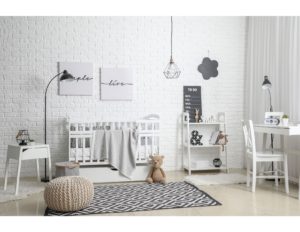
Not all walls are created equal when it comes to blocking out noise. Solid concrete walls offer better sound reduction, but if your baby’s room shares a wall with a noisy neighbour, you may encounter noise leakage issues. In extreme cases of severe noise intrusion, adding an insulated partition wall in front of the existing wall with an air gap between them can significantly dampen external sounds. Additionally, textured wallpapers may help sound absorption, minimizing noise disturbances further. Explore the diverse range of acoustic wall panels available in the market, which come in various designs, to find an aesthetically pleasing solution that enhances the room’s decor while keeping unwanted noise at bay.
5. The Flooring:
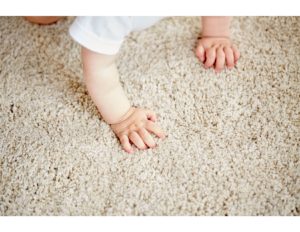
When it comes to sound control in your baby’s room, the type of flooring can make a world of difference. Soft flooring options like carpets and rugs act as excellent sound absorbers, creating a peaceful and cozy environment for your little one. On the other hand, hard surfaces like hardwood, vinyl, or tiled floors tend to reflect sound, leading to increased echoes, especially when someone walks around the room.
If your baby’s room has bare floors, don’t fret! You can easily optimize the sound control by adding large rugs that cover most of the area. Wool rugs, in particular, excel in sound baffling compared to cotton ones. For the best results, opt for tufted and thicker rugs, as they efficiently absorb sounds, providing your baby with a serene space to sleep and play.
6. The Windows:
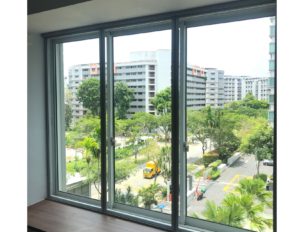
When your baby’s room faces a busy road or is close to a construction site, external noise can disrupt their peaceful sleep and create disturbances. To combat this issue, focusing on soundproofing the windows becomes essential. Tight seals around the window are crucial for reducing sound transmission, particularly if you have sliding windows, which tend to have more gaps, allowing more noise to enter.
If you’re considering replacing your existing window, casement windows offer better sealing when closed in comparison to sliding. You can find valuable insights on choosing a soundproof window on our blog here: How to choose a soundproof window
However, if window replacement isn’t an option or not your preference, we have a perfect solution for you – Magnetite Noise Shields. Our innovative acrylic panels can be easily retrofitted around your existing window, creating an airtight seal that can reduce noise by up to 70%. Say goodbye to outside disturbances and welcome a peaceful haven for your baby with Magnetite Noise Shields. You can learn more about our Noise Shields here: Magnetite Noise Shields for windows.
7. Soft Furnishings:
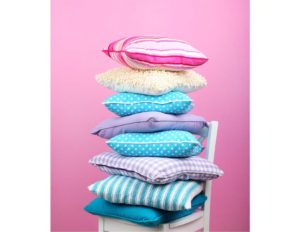
As we’ve previously discussed, soft flooring like rugs and carpets can greatly enhance sound absorption in your baby’s room. However, the influence of furnishings extends beyond just the floor. The same principle holds true for other items in the room.
Hard surfaces, such as concrete, tiles, glass, or hardwood, are smooth and rigid, causing sound waves to bounce off them easily. When these sound waves reflect off hard surfaces, they linger in the environment, leading to an increase in overall sound levels. This phenomenon, known as reverberation, occurs when sound waves repeatedly bounce between multiple hard surfaces, resulting in a noisy or echo effect.
Conversely, soft and porous surfaces, like carpets, curtains, acoustic panels, cushions, blankets, throws, and quilts, absorb sound waves rather than reflecting them. For example, try shouting into your wardrobe and notice how your voice doesn’t echo – that’s because the soft clothing absorbs the soundwaves.
To create a tranquil ambiance in your baby’s room, consider incorporating plush furniture or fabrics, using thick rugs to complement hard flooring, and opting for fabric blinds or curtains instead of wood. By thoughtfully selecting and incorporating soft furnishings, you’ll significantly reduce noise reflections and create a quieter environment, allowing your baby to enjoy a peaceful environment.
8. White Noise Machines:
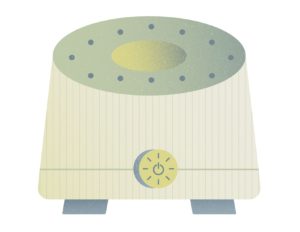
White noise and white noise machines offer incredible benefits for both babies and adults alike. Numerous studies have demonstrated the remarkable effects of white noise on infants, making it a game-changer for their sleep routines. White noise machines function by masking other sounds that might disturb or startle your baby, and they can even replicate sounds that the baby heard while in the womb. This results in a calmer baby who falls asleep more easily and stays asleep for longer durations.
One of the most popular applications of white noise is for promoting better sleep. It works effectively for several reasons. Firstly, white noise serves as a distraction for the brain. A completely quiet room may keep the listener alert, subconsciously waiting for any noise. The continuous sound of white noise provides the mind with something to focus on, without the interference of music or words.
Moreover, white noise helps shield your baby from being startled by sudden noises during the night, as it provides a consistent background sound that muffles any unexpected disturbances.
By incorporating white noise machines into your baby’s sleep routine, you can create a soothing and comforting atmosphere that encourages deeper, more restful sleep.
Creating the perfect sleep environment for your baby doesn’t necessarily mean absolute silence. Your baby is already accustomed to hearing naturally muffled sounds while in the womb. The key is to dampen and soften harsh noises. By implementing effective soundproofing solutions, you can transform your baby’s room into a serene sanctuary that fosters their well-being and happiness. A well-rested baby means a happier family!
We are certain this guide has provided you with the tools to achieve just that. Here’s to a future filled with sweet dreams and cherished memories for your growing family!

